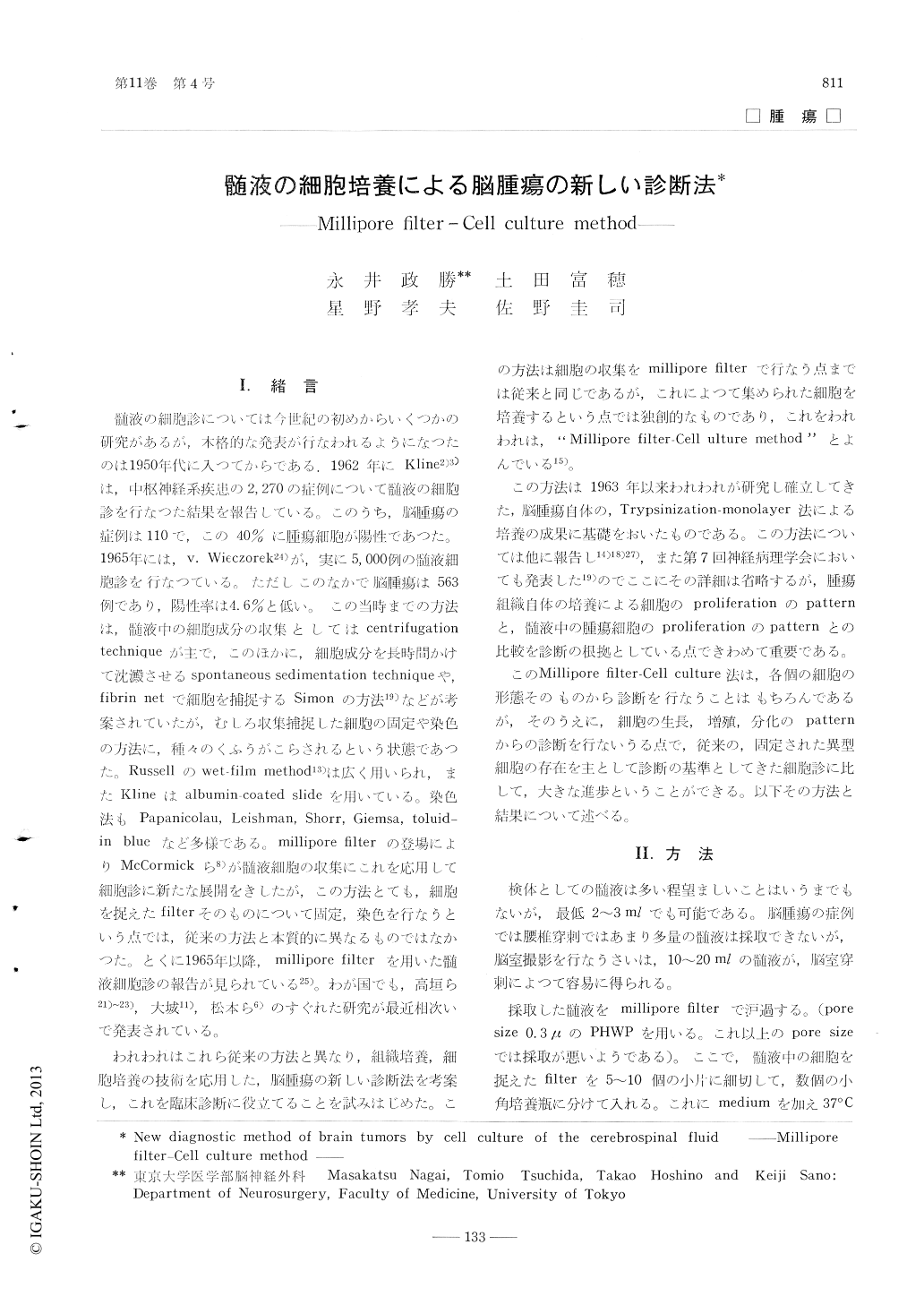Japanese
English
- 有料閲覧
- Abstract 文献概要
- 1ページ目 Look Inside
I.緒言
髄液の細胞診については今世紀の初めからいくつかの研究があるが,本格的な発表が行なわれるようになつたのは1950年代に入つてからである.1962年にKline2)3)は,中枢神経系疾患の2,270の症例について髄液の細胞診を行なつた結果を報告している。このうち,脳腫瘍の症例は110で,この40%に腫瘍細胞が陽性であつた。1965年には,v. Wieczorek24)が,実に5,000例の髄液細胞診を行なつている。ただしこのなかで脳腫瘍は563例であり,陽性率は4.6%と低い。この当時までの方法は,髄液中の細胞成分の収集としてはcentrifugationtechniqueが主で,このほかに,細胞成分を長時間かけて沈澱させるspontaneous sedimentation techniqueや,fibrin netで細胞を捕捉するSimonの方法19)などが考案されていたが,むしろ収集捕捉した細胞の固定や染色の方法に,種々のくふうがこらされるという状態であつた。Russellのwet-film method13)は広く用いられ,またKlineはalbumin-coated slideを用いている。染色法もPapanicolau,Leishman,Shorr,Giemsa,toluidin blueなど多様である。
The cytodiagnosis of the cerebrospinal fluid of brain tumors has been studied by many investigators since the beginning of this century. The application of millipore filter has made a new development of this research.
Recently, we deviced a new method of diagnosis of brain tumors consisting of culture of tumor cells in the cerebrospinal fluid, collected with millipore filter and have applied it to the routine clinical examinations.
Since 1963, we have used trypsinization-monolayer method for the culture of brain tumor tissue and have obtained so good results that almost all of various brain tumors showed flourishing proliferations in vitro. The new diagnostic method which we described in this paper, is based on these results of the trypsinization-monalayer culture of brain tumors.
The method is as follows: We filtrate 3~20ml of the cerebrospinal fluid by millipore filter (pore size of 0.3μ) and collect the cell components in the fluid on this filter, which are subsequently cultivated in small square bottles with the culture medium (Eagle L+ 0.5mg/ml of glucose+30%, of calf serum) at 37℃ by means of stationary culture for 3~14 days. During the culture, neoplastic cells would migrate from the filter, adhere to the wall of the bottle, and grow or proliferate there. The cultured cells were observed, stained by Giemsa staining after 5~10 days culture. Histological diagnosis was done referred with the proliferation patterns of tumorcells which was obtained from trypsinization-monolayer culture of the tumor tissue itself.
We have examined 69 cases of the cerebrospinal fluid by this method. 53 out of 69cases were brain tumor patients and the others non-tumor cases. The percentage of positive specimens in this method was 30% in good proliferations, but it went up to 47% if it included 17% of the cases of poor proliferations. We observed no cell proliferation from the cerebrospinal fluid in the cases of non-neoplastic diseases of the central nervous system.
This method makes a great advantage fordiagnosis. Namely, if there is a cell proliferation by this method, the case may most probably have a neoplasm in the central nervous system. Another advantage of this method, in view point of pathohistological diagnosis, is that dynamic nature of the tumor cells can be observed from the patterns of cell proliferations which is impossible with other methods of cytodiagnosis based mainly on the presence of atypical cells.
We call this new method, " Millipore Filter-Cell Culture method ". We are sure this new method would play an important role in diagnosis of brain tumors in the future.

Copyright © 1967, Igaku-Shoin Ltd. All rights reserved.


